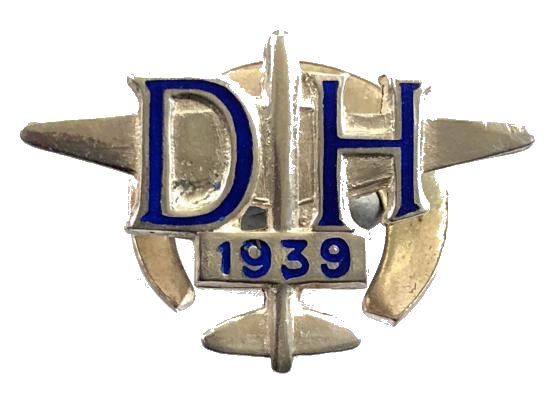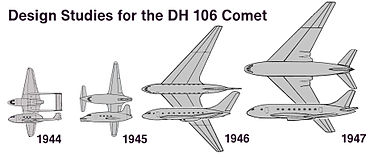de Havilland Aircraft DH.106 Comet
|
|||||||||||||||||||||||||||||
|
|
|---|
.
History de Havilland Aircraft Company de Havilland DH.106 Comet Manufactured 1949–1964 with BOAC First flight 27 July 1949

The de Havilland DH.106 Comet is the world's first commercial jet airliner. Developed and manufactured by de Havilland in the United Kingdom, the Comet 1 prototype first flew in 1949. It features an aerodynamically clean design with four de Havilland Ghost turbojet engines buried in the wing roots, a pressurised cabin, and large windows. For the era, it offered a relatively quiet, comfortable passenger cabin and was commercially promising at its debut in 1952.
Development
Origins

On 11 March 1943, the Cabinet of the United Kingdom formed the Brabazon Committee, which was tasked with determining the UK's airliner needs after the conclusion of the Second World War. One of its recommendations was for the development and production of a pressurised, transatlantic mailplane that could carry 1 long ton (2,200 lb; 1,000 kg) of payload at a cruising speed of 400 mph (640 km/h) non-stop
Fuselage
Diverse geographic destinations and cabin pressurisation alike on the Comet demanded the use of a high proportion of alloys, plastics, and other materials new to civil aviation across the aircraft to meet certification requirements.The Comet's high cabin pressure and high operating speeds were unprecedented in commercial aviation, making its fuselage design an experimental process. At its introduction, Comet airframes would be subjected to an intense, high-speed operating schedule which included simultaneous extreme heat from desert airfields and frosty cold from the kerosene-filled fuel tanks, still cold from cruising at high altitude.

0
KmCeiling
0
KmCombat RANGE
0
MachAircraft Speed
0
Max Crew
Photo Gallery
de Havilland Aircraft Company de Havilland DH.106 Comet
Manufactured 1949–1964 with BOAC First flight 27 July 1949


de Havilland Aircraft Company de Havilland DH.106 Comet Manufactured 1949–1964 with BOAC First flight 27 July 1949
General Info
-
-
-
- Crew: 2
- Capacity: 8 passengers (normal layout), 14 passengers in high density layout
- Length: 50 ft 6 in (15.39 m)
- Wingspan: 47 ft 0 in (14.33 m)
- Height: 17 ft 3 in (5.26 m)
- Wing area: 353.0 sq ft (32.79 m2)
-
-
Powerplant
-
-
- Empty weight: 12,530 lb (5,684 kg)
- Max takeoff weight: 25,000 lb (11,340 kg)
- Fuel capacity: 1,181 imp gal (1,418 US gal; 5,369 L) usable fuel
- Powerplant: 2 × Rolls-Royce Viper 601-22 turbojet engines, 3,750 lbf (16.7 kN) thrust each
-
Performance
-
- Maximum speed: Mach 0.78
- Cruise speed: 454 kn (522 mph, 841 km/h) maximum cruise at (8,534 m)
- Stall speed:154 km/h) EAS flaps down
- Never exceed speed: (547 mph, 880 km/h) IAS
- Range: 1,650 nmi (1,900 mi, 3,060 km) 1,000 lb (454 kg) payload, 45 minutes reserve plus allowances for take-off and landing
- Service ceiling: 41,000 ft (12,000 m)
Links to Youtube & Others
In 2013, the FAA modified its rules to prohibit the operation of jets weighing 75,000 pounds (34,000 kg) or less that are not stage 3 noise compliant, specifically mentioning the 125 series of aircraft. This required any aircraft of the type either to have compliant engines installed, or to be fitted with a hush kit, to fly over most of the United States after 31 December 2015
de Havilland Aircraft DH.106 Comet
In 1961, de Havilland began work upon a small business jet, then known as the DH.125 Jet Dragon.
Youtube Link
The aircraft went through many designation changes during its service life. Hawker Siddeley had bought de Havilland the year before the project had started, but the legacy brand and "DH" designation.













.svg.png)